Catalogue > Search
Results for : Tout le catalogue
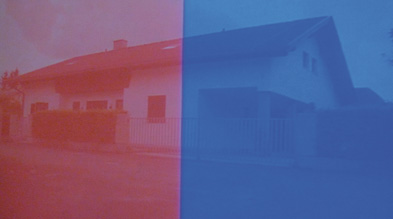
Zitrone
MyStreet
Documentary | dv | color | 12:29 | Austria | 2010
?Welcome to MyStreet. It?s quite a normal Street, don?t you think?? MyStreet Your Street? Everybody?s Street? MyStreet is.. ..a travel to the past ..very personal ..about unnatural division of territory ..harald koelzer ..based on improvisation ..approx. 100 meters long ..a fostex fr-2le ..a collaborative piece ..based on memories ..projected on a wall ..about perception ..Lisa Hall ..based on intuition ..an experience ..16 years of my life ..a composition ..the moment ..a sony ex1 ..michael fisher ..your imagination ..11 hours of audio material ..a stereo piece ..a cliché ..based on digital technology ..reminding you of something? ..herwig steiner ..the truth ..your choise ..energetically unbalanced ..4 hours of video material ..based on knowledge.. an exploration ..a walk without walking ..a zoom h2 ..bernd martinschitz ..sound ..an experiment ..odd ..based on chance ..about people ..you listening with my ears and seeing with my eyes MyStreet. YourStreet.Everybody?sStreet.. ..the latest shortfilms that aram zarikian a.k.a. zitrone presents in the series MyStreet. He is working with sitespecific audio and video material as well as the tools of composition and recordings of prepared improvisation. The viewer is invited into the audio visual field through strangely familiar material, however exotic audio and visual stimuli lead the viewer into a secondary state of adjusted reality where the individual?s imagination is left to complete the journey. The process of production reflects the viewers experience, evolving from a collaborative soundscaping and site specific composition.
zitrone is born 1980 and currently lives in London. He studied Music in Austria and the United States and his strong interest in Sound, Recording and Video Arts began from an early age and developed into passion for Sound Arts and Sound Design.
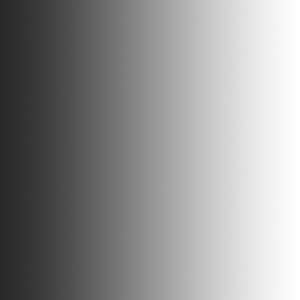
Fokus Grupa
There Aren't Words for What We Do or How We Feel so We Have to Make Them Up
Experimental film | hdv | color | 14:51 | Croatia | 2012
Investigating the relationship of the nationalism towards nature, the work explores the nuances between the political and the escapist. In the film, a central part of the installation, nature is understood as a space beyond: beyond language, culture, media, and as the protagonist realizes, the nature seems to be the very product of that which it is supposed to be an escape from. Through the contemplation of the narrator and the imagery of national and nature parks, film There Aren`T Words for What We Do or How We Feel so We Have to Make Them Up explores both the film medium and the notion of the ?national essence?. Images of nature become the impulse for rethinking of the relationship between representation and reality or rather the relationship of the image and the myth of the nation ? quintessentially connected with the given territory. Through various topographies, from open plains to mountain peaks, the relationship of the narration and the image is free association. The camera intentionally avoids canonical, recognizable natural motives, so they can be placed everywhere and nowhere at the same time. This is also the reason the narrator is not a native English speaker.
Fokus Grupa is an artist collective based in Rijeka and Zagreb, Croatia. Their practice is collaborative and interdisciplinary, and they work across art, design and curating. Their artistic strategies take political shape, without becoming a representational form of ?political art?. Fokus Grupa concentrate on the relations between art and its public manifestations, in terms of working culture, aesthetics, and social and economic exchange values. Their work investigates the inherent power structures of the (art)system. To this effect, they explore it?s economic, spatial and legal implementations. They also explore ways in which politics employs artistic or esthetic means to (mis)appropriate and instrumentalize emotions, reclaiming certain methods back into their art practice. The collective tries to expand the boundaries of the art work, using printed matter, films and installations, works on paper, discussions, workshops and texts. Shows at museums & galleries; Gitte Bohr Gallery (Berlin), NOVA Gallery (Zagreb), GMK Gallery (Zagreb), NCCA (Moscow), HVCCA (New York), MOCA (Rijeka), MOCA (Zagreb), MOCA (Ljubljana), ACCA (Melbourne), SKUC Gallery (Ljubljana), Calvert 22 Gallery (London), Furini Arte Contemporanea (Roma), O3one Gallery, (Belgrade), Jakopic Gallery (Ljubljana), New Art Exchange (Nottingham), Fabbrica del Vapore (Milano)
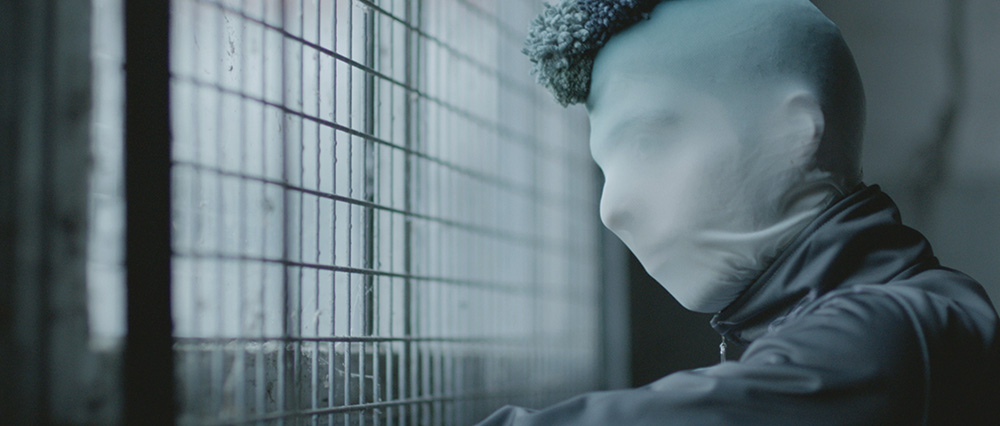
(la)horde
Novaciéries
Video | hdv | color | 16:43 | France | 2015
In the 16 minute movie entitled Novaciéries (LA)HORDE sets up a contemplative situation staging and reinterpreting Jumpstyle, a dance emerged from Mainstream Hardcore, to deliver a mysterious report on the development of a post-internet dance. The film is a global project mixing cinematographic images shot by a movie crew but also performance captations with the cast of the film and homemade videos made by the interpreters themselves shared on youtube and other platforms. The camera follows a singer and dancers wander in an abandoned steel mill. The dancers respond to the lost beat of machinery by executing Hard Jump and Hakken figures while the singer turns a Hardcore anthem "Hardcore to the bone" into a lyrical lament. We are invited to follow the wander of the interpreters until they get together to deliver a show without an audience. All along we waver between the idealized vision of their representation and the reality of its visibility. "Novacieries is a combination of cinema, performance, and home video that transcends dance films and presents a choreographed and metaphysical portrait of the post-industrial world by reinterpreting post-internet dance."
(LA)HORDE is a collective of three artists: Marine Brutti, Jonathan Debrouwer and Arthur Harel. Their body of work is developed through film direction, video installation, performance, stage direction and choreographic creation. (LA)HORDE creates unstable universes and mesmerizing fictions that challenge the viewer into his way of experiencing and apprehending the artwork. Their leitmotiv is to question and swap the codes of different artistic scenes as contemporary art and living art.


- -
Billie Holiday chante 'Fine and Mellow' - Programm
Documentary | betaSP | black and white | 7:0 | USA | 1957
Extraits d?une émission TV de CBS : The Sound of Jazz, live à New-York le 8 décembre 1957


Meta -
Iradia
Experimental video | dv | color | 2:0 | USA | 2005
Iradia Digital film, specially made for the Cronica 021-2005 DVD: "Can I have 2 minutes of your time?". All Images and audio by Meta
Meta is an american artist working with the digital manipulation & synthesis of audio, visual data.


Lia -, @c
Radio_Int.14/37
Experimental video | dv | black and white | 2:0 | Austria | 2005
Radio_int.14/37 is an audiovisual piece commissioned for the "Essays on Radio: Can I Have Two Minutes of Your Time?" CD+DVD compilation from the Crónica media label. As in previous video work from Lia, the music track is created by @c and the video track is built over it using reactive software. The shorter length of this track was predetermined by the structure of the DVD, but it is already a look into the future collaboration piece by Lia and @c built on juxtaposed shorter audiovisual units.
Lia has been working on digital art since 1995, after graduating from the High-school for Students of Music in Graz, Austria. Living in Vienna since then she splits her time between visual design, web art, video and realtime visual performances, apparently different activities that she however manages to bind together trough her unique approach to creativity and production. Over the last years she has also been teaching as an invited teacher at the Fachhochschule Joanneum in Graz, Austria, the École Cantonalle d`Art de Lausanne, Switzerland and the Fine Arts University in Oslo, Norway.


Antmanuv -
Silent arp
Experimental video | dv | black and white | 2:0 | Portugal | 2005
Video byAntmanuv ? Silent HAARP DVD V/A, Essays on Radio: Can I have two minutes of your time? Produced at antmanuvMICRO, Canada 2004 RF.interferenceson the electromagnetic wave by a different electromagnetic entity, outputting different stages/delays
Born in Coimbra Portugal, Tomane Vinagreiro aka antmanuv is a solitary audiovisual experimentalist artist with an interest in expressing feelings with audio and visuals following an order using architecture and facts related with our lives as inspiration. in, out and field recordings are very important strategy to a pre designed input. I sometimes find myself concentrated with sounds from situations that we cannot really notice; they are around us but we don`t really notice their existence. Everything depends on where I`m at and how I feel when I`m there.
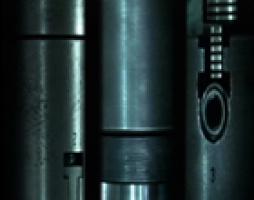

- -
Untitled
Experimental video | dv | color | 12:22 | Korea, South, USA | 2004
With Untitled, Seoungho Cho continues to refine and heighten the issues he has long pursued in his quietly beautiful work. The source material for this video was filmed in a Korean factory and at Information Technology College in Pusan, Korea, with extensive use of macro-focus and close-up. This intense examination of the behavior of industrial machinery is well suited to the precise, exacting quality of Cho`s digital editing, in which "real" images are multiplied, re-sized, and rhythmically sequenced. The soundtrack, composed by the artist, alternates between stretches of silence and periods of eerie noise, complimenting the elegance of this composition. Electronic Arts Intermix
The video works of Korean artist Seoungho Cho are distinguished by a lyrical confluence of complex image processing and sound collage. His works are formalist, almost painterly explorations of subjectivity and the subconscious. These poetic meditations often focus on isolation and estrangement in relation to culture and landscape. Electronic Arts Intermix


Ok.suitcase --, Ok.suitcase
-sf 0905-04
Experimental video | dv | black and white | 2:0 | Portugal | 2005
-sf 0905-04 Digital film, specially made for the Cronica 021-2005 DVD: "Can I have 2 minutes of your time?". All Images and audio by Ok.suitcase
André Gonçalves started improvising and manipulating sound in 1999 having as main instruments a guitar and a computer. In 2001 he starts the "ok.suitcase" project in which he has focused his major attention and developed his major works in sound art and max/msp programming. It`s by the hand of Nuno Moita and "Stapletape" that he presented his sound work live for the first time, and since then he has been playing live with them. At the same time he`s the author of the electronic rhythms, synthesis and sound manipulation in the project "In Her Space" and he is playing live with the improv project "Last Time This Happened We Had a Street Party". Keeping the improvisation concept in mind and always working in real-time he has worked in sound design for theatre with the "Inestética Theatre Company". In video art he has been developing works for record labels, musical projects and for it?s own project ?ok.suitcase?.
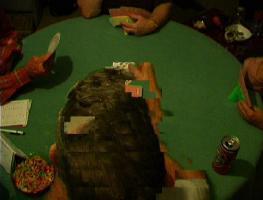

.sue.k. .
card 4
Experimental video | dv | color | 8:0 | Australia | 2003
"Card 4" provides a four position view of a group of friends playing cards. Each is seen from above one of the four players giving only the back of the head and the hands at play. During the work, the different views are woven together mimicking the circular activity of card playing. As a result of the capturing method used the imagery itself is fractured. This gives an additional layer to the visuals of the piece. The soundtrack that accompanies "Card 4" originates from the video recordings of the game at play. In the first half of the work, it is taken directly from the source material at an accelerated speed. The audio of the second half of work is obtained through a degenerative process from the original sound recording. Both sections of the audio were edited in the same weave pattern as the visuals making it difficult for the viewer to establish any familiar sound, it provides the key for interpreting the editing sequence of the overall piece. Its shift in rhythm and tone indicates the subtle changes in the visuals.
sue.k. is a West Australian artist that has been living in London for the past two years. Over the years she has exhibited extensively using a variety of mediums in the areas of experimental video, drawing, sculpture and painting. Her video work has been screened throughout Australia and in the United Kingdom, United States, Germany, and France.
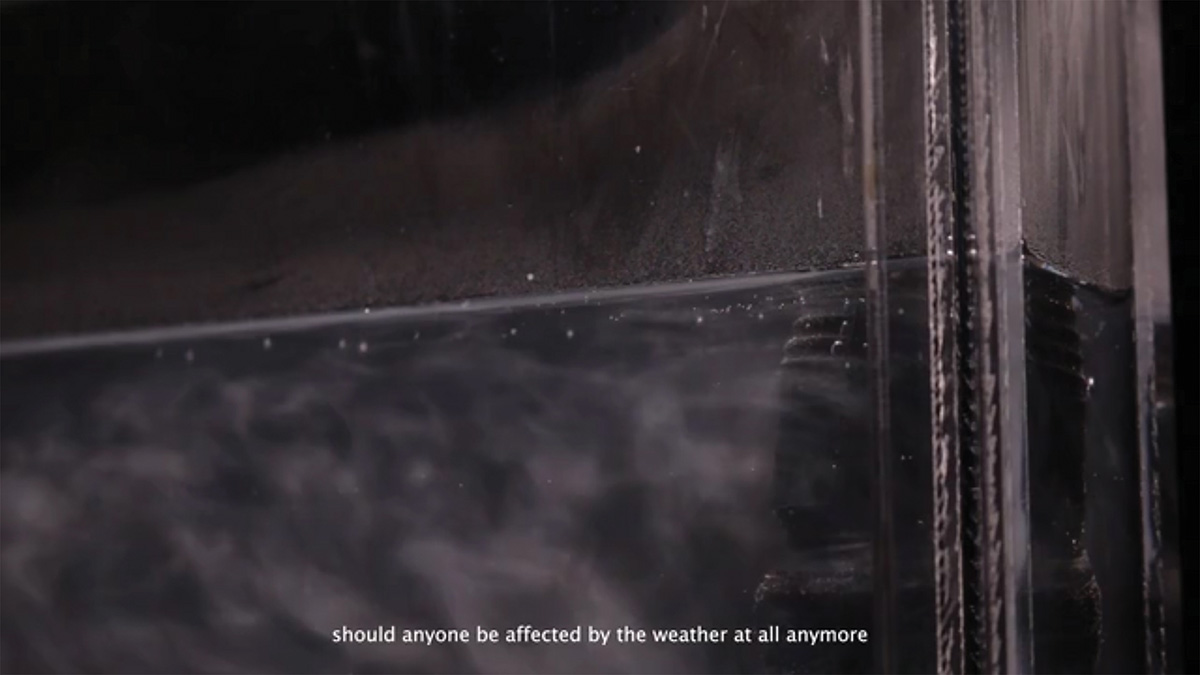

Sunder Aarti
Ghost Cut: Some Clear Pixels Amongst Many Black Boxes
Video | mov | color | 22:11 | India | 2021
This film draws from conversations with Amazon Mturk workers and their relationship with the politics of the Mechanical Turk platform – the varying forms of transparencies and opacities that make the platform what it is. Focusing on the backend of AI and machine learning processes, the film investigates the relationships between the analogic, the digital and the terrestrial. What kind of work is required for smooth functioning of automation? Who does this backend work, where does it take place, and what does it entail? Using the very processes that workers help train on online platforms as material, recursions of different scales takes place, where we see language, the ability to define and speak clear English as central. A second focus is an exploration of the subjective nature of data gathering, processing and annotating, and the material infrastructures it is dependent on. In the absence of any fixed constants, context or averages, abstraction emerges as an important and forced tool.
Aarti Sunder’s research and practice lies at the crossroads of the digital humanities and contemporary art. She is interested in the fictions arising from investigating situated experiences and asking if these help us re-think the ways in which we understand technology and our relationship with it. So far she has focused on contemporary labour practices, fictional edges of protest, myth and digital-terrestrial play. Aarti’s interest is to problematize the determined linearity of ‘progress’ inscribed within the promise of the algorithm, technological prowess and a quantifiable future. Looking at globalised framework of precarious labour, non-human exhaustion and storytelling that lies at the strategic intersection of power, knowledge and aesthetics. Relooking at these intersections, she believes, can help us tell better stories, of fictions past, present and future. Among other places, Aarti will exhibit her work at the forthcoming 67th BFI London Film Festival and in collaboration with Doreen Mende at Albertinum of the State Collections of Art in Dresden. She has previously shown at Akademie der Kunst, Singapore Biennale 22, Hayy Jameel, MIT, Warehouse421, the Goethe Institute in Chicago, Kunstverein Leipzig, Bauhaus Imaginista, Alserkal Avenue, Ashkal Alwan, ISCP and the Museum of Yugoslav History. She has been the recipient of many grants and fellowships from MIT, Sommerakademie Paul Klee, Harvard FSC Film Center, Art Dubai and Ashkal Alwan and the Sharjah Art Foundation. Aarti Sunder works with video, drawing and text and sculpture.
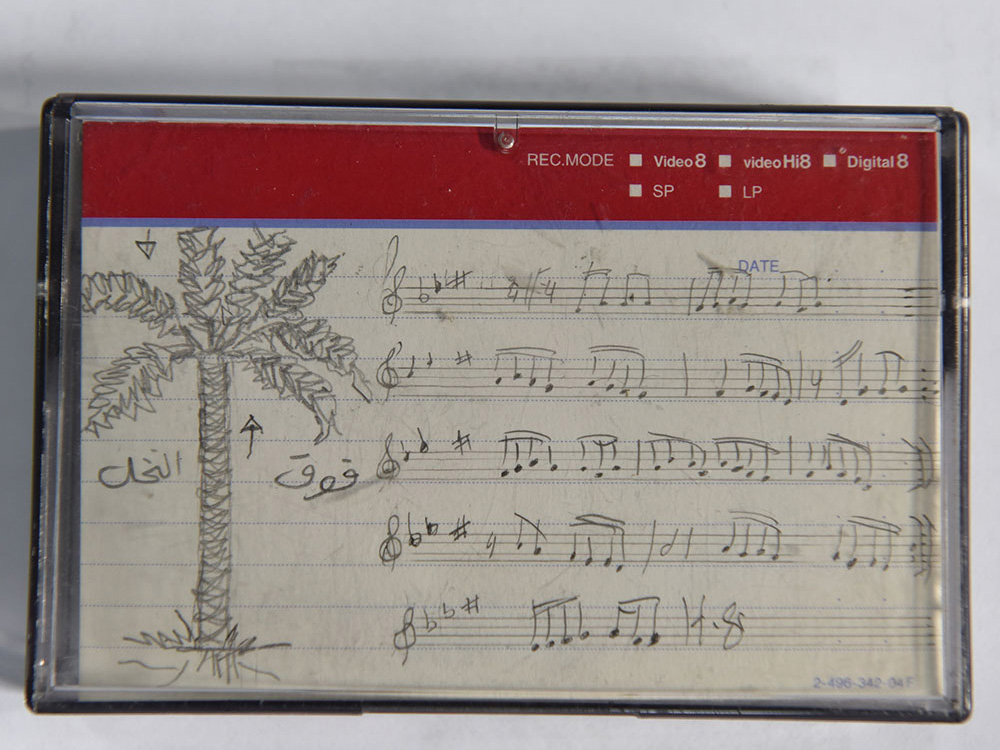
Sherko Abbas
The Music of the Bush Era
Experimental doc. | hdv | color | 7:3 | Iraq | 2017
The theme of music is represented by work of Kurdish-Iraqi filmmaker Sherko Abbas: The music of the Bush era. in a split-screen video, using footage shot by his sister, a cellist in the Iraqi National Symphony Orchestra, he demonstrates how in 2003 the US administration, instead of helping the orchestra to properly re-establish itself in Iraq, militarily airlifted the entire orchestra to Washington to perform once at the Kennedy Centre before President Bush. his film is critical of this futile propagandistic gesture, enacted in the shadow of the invasion in March of the year to promote neo-liberal values, and escape censure. The work was partially inspired by Slavoj Zizek's analysis in his Pervert's Guide to Ideology of the widespread ideological use of Beethoven's Ode to Joy from his Ninth Symphony.
Sherko Abbas Born in 1978, in Sulaymaniyah, Kurdish Autonomous Region, Iraq. Lives and works in United Kingdom. He studied Fine Art in Sulaymaniyah and graduated with Master of Fine arts at the Goldsmiths University of London in 2015. He employs the media of video, performance, text and sound in his practice dedicated to the sonic and visual memory and geopolitical situation of contemporary Iraq and Kurdistan in Particular. He has participated in many exhibitions including his work THE MUSIC OF BUSH ERA was Shown in last Iraqi pavilion (Archaic) in Venice Biennale 57th, the Bagdad mon amour in ICI Paris, Vernacularity, Alternativa International Visual Arts Festival in Gdansk, Poland and the Estrangement in showroom London, Freedom at the barricades? Vaxjo Art Hall, Vaxjo, Sweden.
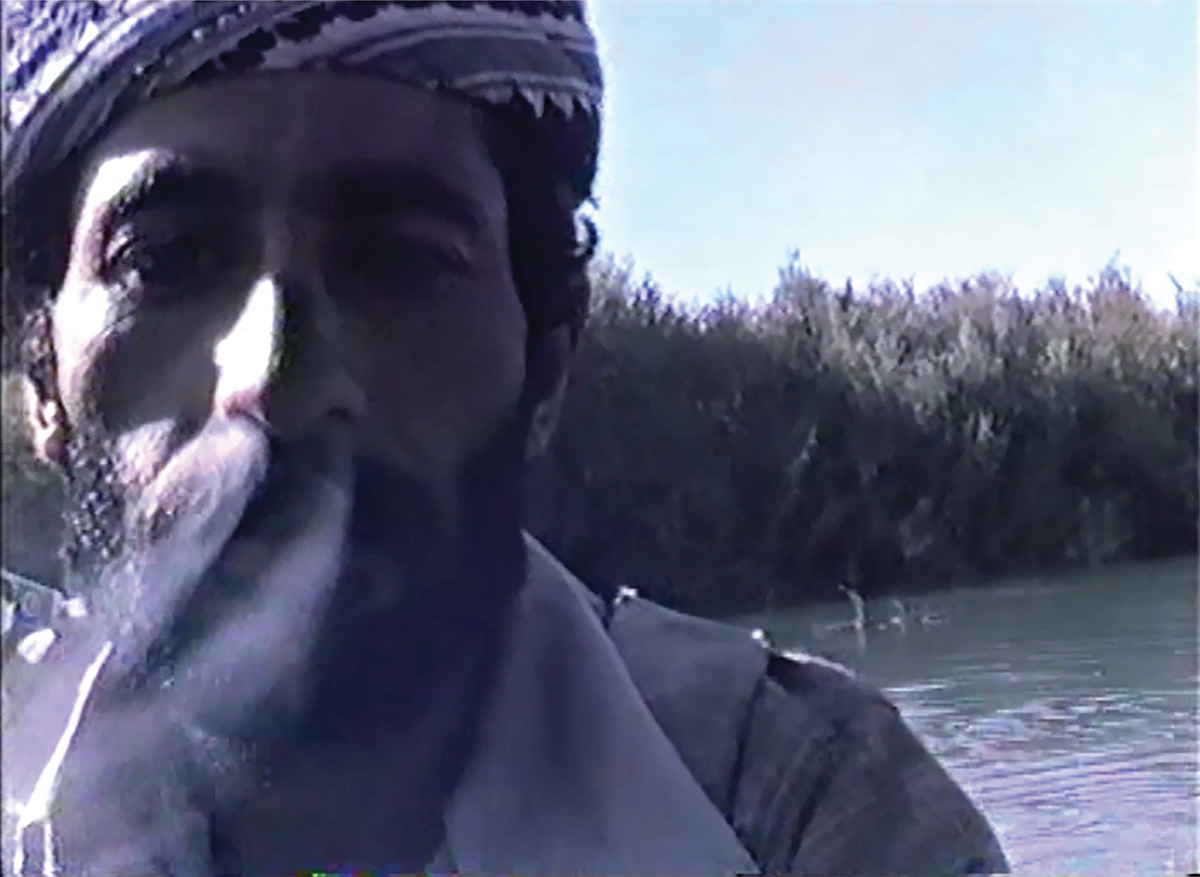

Sherko Abbas
Silence Along the River
Experimental doc. | mp4 | color | 7:0 | Iraq | 2021
In 1985 a group of Kurdish fighters, known as a "Peshmerga", on a mission to attack one of the army’s camps in the north of Iraq. They took the Sirwan river by a small raft to cross the area which was controlled by the Iraqi army. This footage is part of an old archive taken by my father Abbas Abdulrazaq, a former Kurdish fighter and cameraman. He accompanied this group of Peshmerga to document their activity during the mission. Despite all the risks they have taken, the battle didn’t happen. Consequently, my father filmed them when they were singing a song. I was very intrigued by his action, so I asked my father why this particular footage never showed before? He mockingly replayed who wishes to watch a film that has no fighting scenes?
Sherko Abbas is a Kurdish-Iraqi artist. He was born in Iran in 1978, where his family lived as refugees. They returned to Iraq when he was two years old. Abbas studied Fine Art in Sulaymaniyah, Iraq and earned a Master of Fine Arts degree from Goldsmiths College, University of London in 2015. His work explores sonic and visual memory, with a focus on modern memory that relies on recorded materials. Additionally, Abbas is interested in the current geopolitical situation in Iraq. Abbas’ works have been exhibited and screened internationally including at: Archaic, the Iraq pavilion at the 57th Venice biennale; Theater of Operations, MoMA PS1, New York; May Flames Pave the Way for You, Arsenal gallery, Bia?ystok; Push Festival, Manchester , UK; Towner International, Towner Eastbourne, Eastbourne; Speaking Across Mountains, Middle East Institute, Washington D.C.; Baghdad Mon Amour, Institut des Cultures d’Islam, Paris; Vernacularity, Alternativa Festival, Gdansk; Estrangement, The Showroom, London. Also, his moving image works were screened at the Independent Iraqi Film Festival's online screening, the 38th Kassel Documentary Film and Video Festival in Kassel, Germany, Aashra, Ashkal Alwan Online Film, Rencontres Internationales Paris/Berlin at the Louvre Auditorium in Paris, the Open City Documentary Combined Programme: What Rules The Invisible in London, Visit Festival Het Bos Ankerrui 5-7 in Antwerp, Belgium, Ruya Shop in Baghdad, and Shasha Movies online streaming. Abbas also works as a curator, organizer, and coordinator of cultural events. He was the operations manager for the "Post-war Culture in Iraq" project (2010) and curated the Clamour project (2016). In collaboration with curator Aneta Szy?ak, he researched and coordinated the "In-between Worlds: Kurdish Contemporary Artists" project. This resulted in a collection of artworks from over 30 Kurdish-Iraqi artists and a book. The collection is now part of the Imago Mundi collection under the auspices of the Fondazione Benetton Studi Ricerche in Treviso, Italy.
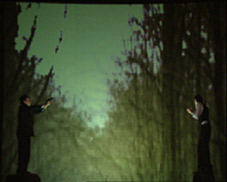

Houri Der Stepanian Abdalian
Living man
Experimental video | dv | color | 3:0 | Canada, France | 2005
Merging of an escaping man and a landscape.
Houri Der Stepanian-Abdalian received his education at the Ecole Nationale Superieure des Arts Décoratifs of Paris (2002-2004) and at the Ecole des Arts Visuels et Médiatiques at the University of Quebec in Montreal (Master es Arts, 2001-2004). She realized the performance ?Hands up Motherfucker?, with André S Labarthe and Haïr Hratchian, in the Panorama 6 framework (production Fresnoy, Studio National), June 2005. Her installations multimedia have been exhibited in France and abroad, notably: ?Still Life with Voice, Water Glass and Vase?, a production of the CIAM-Hewagram, which was presented at the Glareie La Fabriq in January 2005. Field crossing artist, she worked as an interpret for the installation ?Madame Marie Curie: A series of Portrait taken in 1902?, by Davif Thomas presented at the ZKM, from Jully 23rd ot October 9th 2005. She recently recorded a vocal performance for the interactive installation ?Beauté Désincarnée? by Juhana Pettersin at the Fresnoy, Studio National, in June 2005, and played the principal role of Klara in the shrot length movie ?Le Vaurien? by Gaspard Hirschi in November 2003. There is among her older installations: ?Forwarding Objects?, presented at the Centre de Diffusion of the EAVM in 2001, ?Le Lieu et son contenu imaginaire?, presented during the first triennial of ?L?art qui fait Boum? in 2000 and ?Entre Perte t Translation? presented at the Galerie de l?UQAM in 1999. Her video work was diffused many times in public screening framework, notably: ?Livingman? (Le Fresnoy, Studio National, 2005), ?The disorder of His Shirt and Tie Worried Him? ?Le Fresnoy, Studio National, 2005), ?Gaspard?? (Fest-Hiver Festival, Lavitrine Limoges, 2003-2005), ?A Numeraical Adaptation of The Brechtian Theatre? (CDEX, EAVM, 2002), ?Autopoesis? (Festival EICV, Cinémathèque Québécoise, 2000), and ?Ulrich? (Festival EICV, Maison de la Culture Mont-Royal, 1996). She works and live in France and Canada.
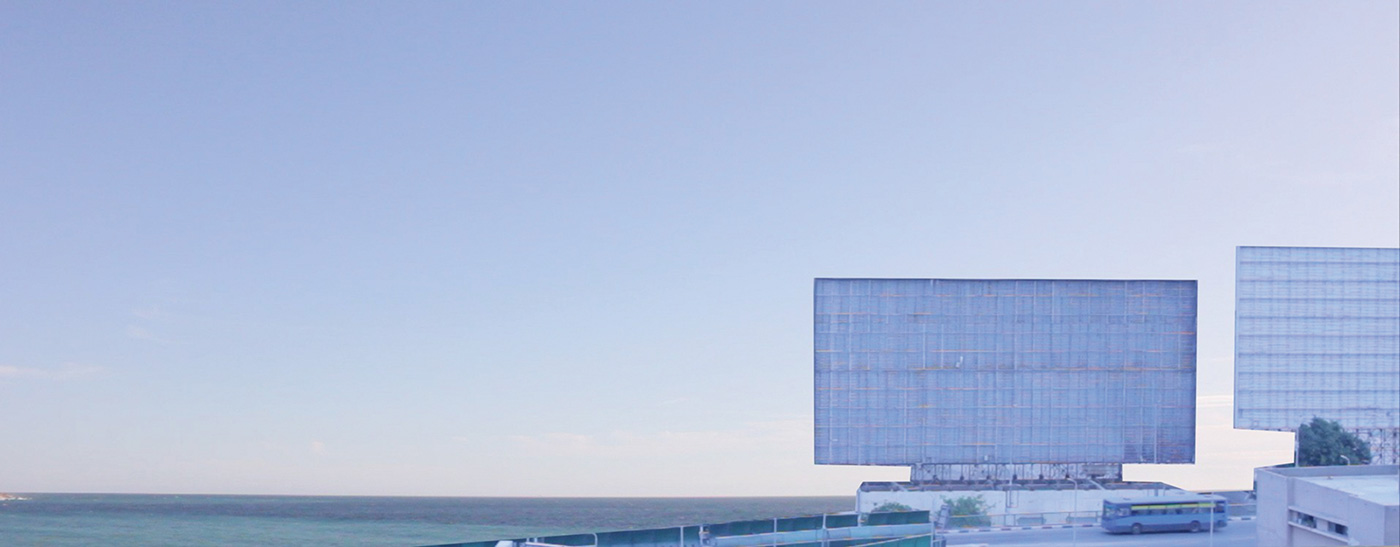
Mohamed Abdelkarim
Gazing...Unseeing
Experimental fiction | mov | color | 7:50 | Egypt | 2021
The video speculates a future scenario demonstrated in a climate fiction narrative. The narrative is based on a pseudo interview with an imagined fugitive in a post-disaster era. Through different positions, ideological turns, and economic sovereignty, the interview imagines the future of the greens, governments, and private sectors in a post-flood city. The landscape and fiction narrative complicates the relationship between infrastructure, privatization, ecology, surveillance, and migration.
Abdelkarim is a visual artist, performer and cultural producer. After completing his M.A. at ECAV/Edhea, Switzerland, 2016 he turned towards producing text-based performances and became committed to performative practices based on multidisciplinary research, employing and reflecting on narrating, singing, detecting, doing, fictioning, and speculating. In Abdelkarim's performative works, the script bears witness to the research experience. The emphasis is on the process, as a reflection on production and cultural genealogy. This process is open-ended, and non-linear. His current umbrella project focuses on the agency of the landscape as a witness to "a history we missed and a future we have not yet attended" His performances have been included in Guild Master of Cabaret Voltaire, Manifesta 11, Zurich, 2016; Sofia Underground Performance Art Festival, Bulgaria, 2016; Photo Cairo 6th, Contemporary Image Collective (CIC), Egypt, 2017; Live Works Performance Act Award Vol. 5, 37° Edizione Drodesera, Trento, Italy, 2017; At the Crossroads of Different Pasts, Presents and Futures, Fondazione Sandretto Re Rebaudengo, Turin, Italy, 2018; Interazioni Festival, Rome, Italy, 2022; and Festival Internazionale della Performance, Performative 04, at MAXXI L'Aquila, 2024. As part of his performative practice, he established "Live Praxes", a performance encounter that includes workshops, seminars, and performance nights.

François Abdelnour
Les Naufragés
Experimental doc. | hdv | color | 24:0 | France | 2012
A group of men that we know nothing and that nobody understands a train which cuts through the cold night. A trip to a mysterious quest.
.
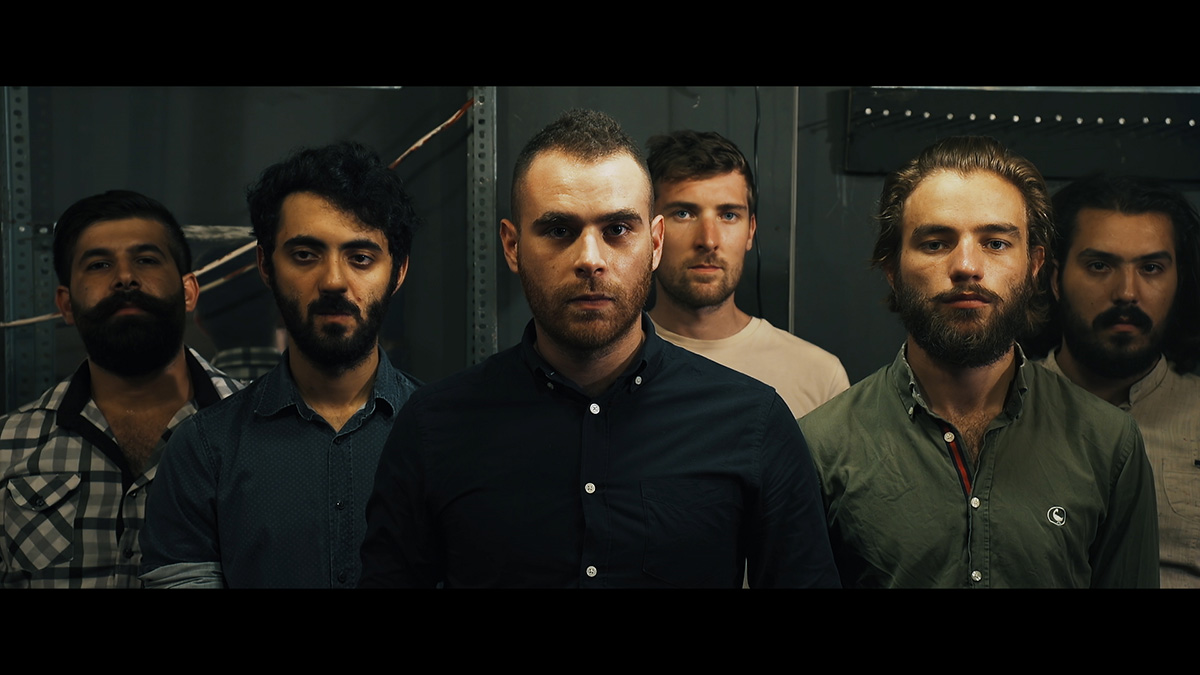
Noor Abed, Mark Lotfy
One Night Stand
Experimental doc. | mov | color | 24:0 | Palestine, Egypt | 2019
The film is based on the filmmakers’ actual encounter with an unknown European man, one night in a bar in Beirut. It was a fighter on the road to join the Kurdish militia fighting in the war against the Islamic State on the territory of Syria. The conversation was secretly recorded on a cellphone and serves as the script for animated modeled situations and performative reconstructions of that night. The film is also a formal polemic on the apparent authenticity of the documentary and the possibilities of representation of reality by means of simulations and modeled situations.
Noor Abed (b.1988 Jerusalem) is an interdisciplinary artist and filmmaker. She creates multimedia works on the boundary of performance, film and new media. Her practice examines notions of choreography and the imaginary relationship of individuals, creating situations where social possibilities are both rehearsed and performed. Her current research is concerned with the concept of Myth and the form of Magic Realism - and its close relation with colonial and post-colonial discourses. Mark Lotfy (b. 1981 Alexandria) is an experimental filmmaker. He explores the boundary between fictional narratives, documentary film, and media art. His practice questions the everyday, the contingent and the virtual. His current research is concerned with notions of nationalism, fundamentalism, emotionalism and heroism - not only through their ideological and performative mechanisms, but also technological ones. He examines framed structures in which new alienated subjectivities are being produced.

Maite Abella
Het wachten
Film experimental | 16mm | color and b&w | 15:40 | Netherlands | 2008
Synopsis A woman is running through a deserted city. To keep running is the only way to live in these streets. She is not hasty, she is quite serene, but maybe lost. In fact we don?t know exactly the raison but the woman can only live in the city through this universal run. While she is running, we see eight group portraits inspired by the composition of Dutch XVI-XVII Century paintings, those are the ones who wait. Finally she arrives at an unexpected panorama: a beautiful canal that inspires a meditative moment in her. She jumps into the water looking for the final communion with the inner city, and magically reaches the other side of the canal.
Biographical note Maite Abella (born 1966) is a Spanish artist . Born in Lleida (Spain) in 1966, Maite Abella attended Gerrit Rietveld Academy in Amsterdam, where she received a Bachelor of Fine Arts Degree in Painting. She also attended Universitat de Belles Arts in Barcelona (Spain). She has a Bachelor of Arts Degree in Geography from the Universitat de Barcelona (Spain). In 2001 she was nominated for the Buning Brongers Award for painting and in 2003 she got The Starters stipend Dutch National Fundation for the Arts (The Netherlands). She has exhibited her paintings since 1999 regularly in The Netherlands. Since 2000 Abella makes short films and also she has developed site-speficic projects in the public space.
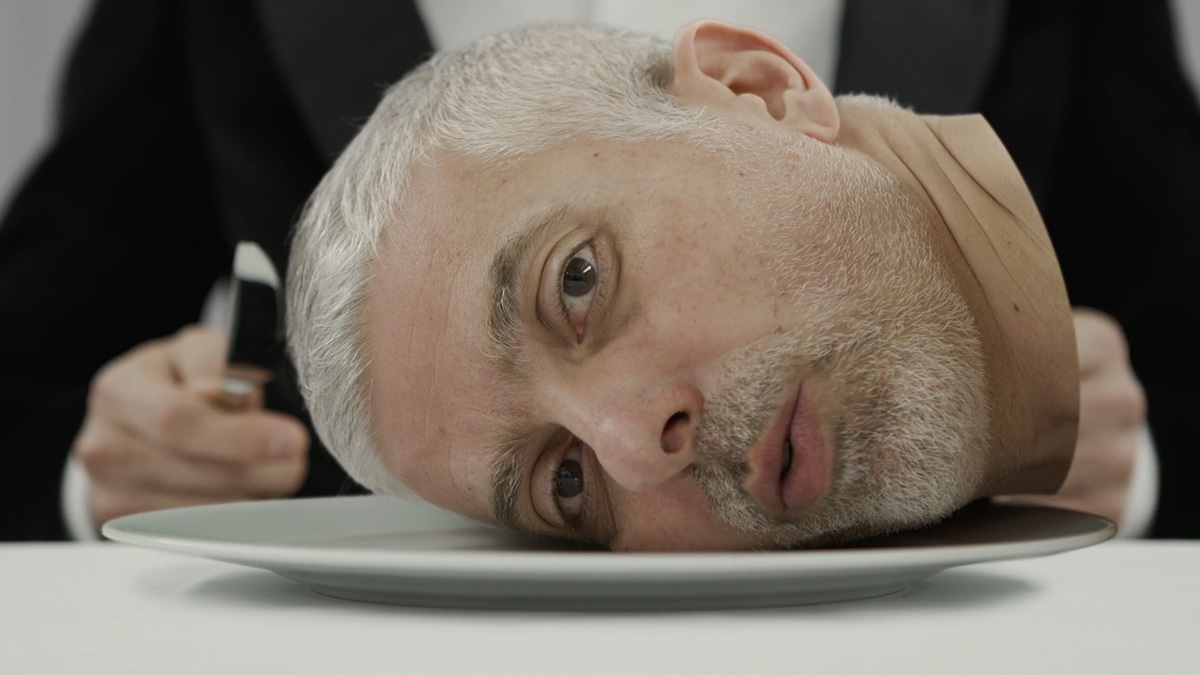
Adel Abidin
Musical Manifest
Video | 4k | color | 10:0 | Finland | 2022
When I immigrated to Finland, I started facing a deep shock regarding the differences between the two cultures. Finding myself on the border between the two helped my practice but distracting for my selfdom, affecting my decisions and creating a fertile ground for confusion and turmoil. When the world slowed down during the pandemic, I decided to turn my lens and start investigating my identity and perspective. I exposed myself to all the possible ways to understand what had indeed gone wrong in the process of figuring out a third self that came to be me. Music was the best path to pursue this exploration, and I made six music videos where I sang and acted as the protagonist. Intermixed from many different songs, where many viewers will recall, the lyrics resonate with the contemplation of my meanings in my life. I work with the themes of identity, power, fear, clichés, slippages, and uncertainties in language by manipulating well-known pop song lyrics once used to express love, hope, and dreams. The rearrangement of these lyrics illustrates a harsh yet honest tool that represents what we hide or are afraid of making known.
Adel Abidin was born in Baghdad (1973) and currently resides between Helsinki and Amman. He received a B.A. in painting from the Academy of Fine Arts in Baghdad (2000) and an M.F.A from the Academy of Fine Arts in Time and Space Art in Helsinki (2005). Since his representation of Finland at the Nordic Pavilion in the 52nd Venice Biennale (2007), his work has been the subject of major exhibitions worldwide including: Van- haerents Art Collection, Brussels (2015), 56th Venice Biennale in the Iranian Pavilion (2015), The Glasstress-Goti- ka, 56th Venice Biennale, International Exhibition, Palazzo Franchetti (2015), 5th Guangzhou Triennial, The Guang- dong Museum of Art, Guangzhou (2015), The Pera Museum, Istanbul (2015), Aga Khan Museum, Toronto, Canada (2015), Gwangju Museum of Art, South Korea (2014), The Jerusa- lem Show VII, Jerusalem (2014), Louisiana Museum of Modern Art, Denmark (2014), MACRO-Museum of Contempo- rary Art, Rome (2014), Mori Art Museum, Tokyo, Japan (2013-2012), 54th Venice Biennale, Iraq Pavilion (2011), 10th Sharjah Biennale, UAE (2011), MOCCA, Toronto (2011), Mathaf: Arab Museum of Modern Art, Doha, Qatar (2010), 17th Biennale of Sydney, Sydney (2010), MAP, Mobile Art Production, Stockholm, Sweden (2009), 11th Cairo Bienni- al, Cairo (2008), Screening at MoMA, Museum of Modern Art, New York (2008), Art Paris, Grand Palais, Paris (2008), Espace Galley of Contemporary Art, Louis Vuitton, Paris (2008), The Mildred Lane Kemper Art Museum, St. Louis, USA (2008) and The 4th Gothenburg Biennale, Sweden (2007). He has been represented in galleries including: Hauser & Wirth Gallery, London (2013), with his well-recognized three channel video installation "Three Love Songs", Lawrie Shabibi Gallery, Dubai (2013), with his suspended light based installation "Al-Warqaa" (Chosen as the image of the rising Arab art scene in Dubai by the New York Times), Anne De Villepoix Gallery, Paris (2011), with his six channel video installation "Their Dreams" and Zilberman Gallery, Istanbul (2011), with his well received video installation "Ping-Pong". Abidin's work continues to be well represented in both Private and public collections including those of the KIASMA- Musuem of Contemporary Art, The National Gal- lery, Helsinki: The National Gallery of Victoria, Mel- bourne, Australia: The Sharjah Art Foundation, UAE: Mathaf- Arab Museum of Modern Art, Doha, Qatar: EMMA- Espoo Museum of Modern Art, Espoo, Finland: Nadour Private Collection: Kamel Lazaar Collection: The Barjeel Art Foundation, UAE: The Heino Art Foundation, Helsinki: Darat al Funun - The Khalid Shoman Foundation, Amman: HH Sheikh Zayed bin Sultan bin Khalifa Al Nahyan, UAE: KOC foundation. Abidin has been selected for the Finland Prize for Arts in 2015, Received a Five Years Grant from The Art Council of Finland (2012-2017) and in 2011 He was a nominee for the Ars Fennica Prize in Finland. In (2015) the Artist has taught, gave talks and panel discus- sions, at various venues including the UNESCO- Improving Artistic Freedom In a Digital Age, Helsinki (2016), the Acade- my of Fine Arts in Helsinki: Lasalle- College of the Arts: TAIK- Alto University, Helsinki (2014), The Museum of Anthropology, Vancouver (2013), The Mosaic Rooms, Global Futures Forum, London (2013), Darat al Funun - The Khalid Shoman Foundation, Amman (2011), OSU- Oregon State University, USA (2010). Location One Gallery, New York (2010), The Academy of Arts, Baghdad (2001). Abidin has been a Subject in Art documentary about his art Practice in many Tv channels including BBC- culture channel, England (2011) and ARTE- cultural channel, France (2008). also his work was mentioned in major newspapers and magazines around the world including (The NewYork Times- 2011 & 2013), Le Monde, Le Figaro, the National in Dubai, Helsingin Sanomat, the Wallpaper magazine, The Wall Street Journal, Canvas Art Magazine, Art Forum, Art in America, Avek Media Art Magazine, Taide Lehti, ArtAsiaPacific…Etc
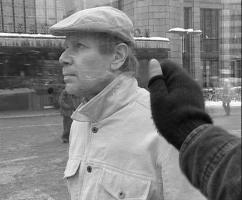

Adel Abidin
Crazy Days
Experimental fiction | betaSP | color and b&w | 13:30 | Iraq, Finland | 2005
An Iraqi immigrant man living in Finland, who is only physically and not mentally integrating with the Finnish society, gets his own attitude reinforced by constantly being approached as an outsider by Finns. The film shows a collection of impressions this Iraqi man has gathered while in Finland. As an invisible spirit he enters the house of a Finnish woman, and sees her life through his eyes. He walks in the streets and in the forest and the film visualizes his associations, he links Finnish rituals with Iraqi. The film is saturated by loneliness and the experience of distance between people.
Curriculum Vitae Adel Abidin born in Baghdad 1973, lives and works in Helsinki / Finland Education: 2005 MFA, Academy of Fine Arts, Helsinki 2000 BA, Academy of Fine Arts, Baghdad. 1994 B.Sc. in Industrial Management, Mansour University College, Baghdad. Solo Exhibitions: 2004 Two Projects, video installations, Kuvataideakatmia Galleria Oil Paintings, an installation, Kaapelitehdas, Helsinki 2002 Reflected Truth, Kaapelin Galleria, Helsinki Land, Inaa Gallery, Baghdad 2001 Under siege, Galleria Primavera, Helsinki 1999 Millennium 3, Inna art gallery, Baghdad. 1990 Carbon on Paper, Alweya Club, Baghdad. Group Exhibitions: 2005 Istanbul Biennial, September, Turkey The Holden Gallery, Manchester, October UK Rantakasarmin Gallery, suomenlenna, June Helsinki Tennespalatsi Art museum, May, Helsinki Performance with Alexander Nikolic, Huuto gallery 2004 Blank Space, new contemporary space, Screening, Sydney, Australia Katakomben, international festival, ?Seller?, Berlin Finnish- Russian exhibition, Lahti / Finland London Biennial, UK 2003 Stockholm art fair, Stockholm Miniteos, Kaapelitehdas, Helsinki 2002 Petit Format, Galleria Primavera, Helsinki Circus, Kaapelitehdas, Helsinki Contest of young Iraqi artist- Athar Art Gallery, Baghdad 2001 Christmas Exhibition, art on paper, Slovenia Summer Exhibition, Kaapelitehdas, Helsinki 2000 Irak: terre oubliée, Paris-France Spring Exhibition, Inaa Art Gallery, Baghdad. Spring Exhibition, Iraqi Arts Center. 1999 Art Day Exhibitions, Iraqi Arts Centre. Babylon Festival Exhibition, Iraqi Art center Contest for Contemporary Iraqi Sculpture, Hiwar Art Gallery, Baghdad Iraqi contemporary Art exhibition, Alwan Art Gallery, Beirut 1998 Solidarity with the People of Palestine Exhibition, Inaa Art Gallery, Baghdad 1997 Selected Works of Iraqi Contemporary Art Exhibition, Inaa Art Gallery, Baghdad Summer and Spring Exhibitions, Orfali Art Gallery, Baghdad Workshops teaching: 2004 Democracy through collaboration, workshop, Kiasma, February Public space and Mapping, Helsinki, workshop, Kiasma, December Awards: 2002 First Prize - Contest of Young Iraqi Artists. Shakir Hassan Al Sai?d Award. 1999 Third Prize - Contest of Contemporary Iraqi Sculpture. Ismail Fattah Al-Turk Award Grants: 2005 The Art Council of Finland / Travel grant Suoamen kulltuurirahsto (Finnish cultural foundation) AVEK / Promotion for audiovisual culture 2004 The Academy of Fine Arts 2003 The Arts Council of Finland 2002 The Arts Council of Finland Selected Reviews, Articles and TV programs: 2005 YLE, channal Teema, Crazy Days Helsingin Sanomat, September 25th, Istanbul Biennial "art-ist" contemporary art magazine`s special issue on Finnish art scene, Sureyya Evren, Istanbul, Turkey 2004 Yle TV2, Artur, September 21, Patsy Nakil Helsingin Sanimat, February 12, ?Musta öljy?, Marja-Terttu Kivirinta 2003 Helsingin Sanomat, April 25, ?Bagdad, Detroit, Helsinki?, Marja-Terttu Kivirinta Yle TV1, Valopilkku, May 8, ?Kuvataiteilija Adel Abidin? Yle TV2, Artur, April 7, Adel Abidins balansg ng bland kulturer och konst 2002 Helsingin Sanomat, July 13, Exhibition Review, Anne Rouhiainen Hufvudstadbladet, May, ?Ssant S_ sant!? Bianca Grasb January, interview, Iraqi Satellite Channel 2001 Jordan Times article, June. Hufvudstadbladet, April 26, Fr_n f_rtryck till livsgl_dje, Dan Sundell Lauantaivekkari, April 28, Taide studiossa Adel Abidin Professional Memberships: AV-ARKKI, Distribution Center for Finnish Media Art Muu-ry, Media Art organization International Association of Art (IAA, AIAP) Finnish Painters Union (TML) ? ?kokelas? Helsinki Artists Association Kaapelitehdas Artists, Helsinki Iraqi Artists Association Iraqi Plastic Artists Union
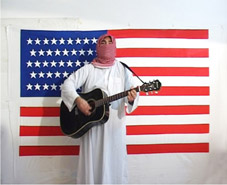

Adel Abidin
Jihad
Experimental video | dv | color | 3:27 | Iraq, Finland | 2006
The scene is a familiar one, seen far too often in news coverage of the war in Iraq: the videotaped message of the Islamist "terrorist", with a covered face and a Kalashnikov in his/her hands, reciting a message of hate and death from the Koran. In this version of the videotaped message, the "terrorist" is standing in front of the Stars and Stripes painted on the wall behind him. He starts by reciting a verse from the Koran, and then picks up an acoustic guitar and sings, "This land is my land".
Adel Abidin was born in Baghdad in 1973, and now lives and works in Helsinki, Finland. Education: 2005 MFA, Academy of Fine Arts, Helsinki 2000 BA, Academy of Fine Arts, Baghdad University, Baghdad 1994 B.Sc. in Industrial Management, Mansour, Baghdad University, Baghdad Awards: 2006 Artist of the month, September, FRAME, Finnish Fund for Art Exchange 2005 Audience award, LUKSUZ film festival, Slovenia 2002 First Prize - Contest of Young Iraqi Artists Shakir Hassan Al Sai?d Award 1999 Third Prize - Contest of Contemporary Iraqi Sculpture. Ismail Fattah Al-Turk Award, Woman Under Sanction. Grants: 2006 Suomen kultuurirahasto (Finnish Cultural Foundation), VOID AVEK, promotion for audiovisual culture, VOID 2005 The Art Council of Finland, Travel grant, SHEEP FOR SALE, Suoamen kulltuurirahsto (Finnish cultural foundation), CRAZY DAYS AVEK, Promotion for audiovisual culture, CRAZY DAYS 2004 The Academy of Fine Arts, SERMON 2003 The Arts Council of Finland, 19:25 AFTER THE WAR 2002 The Arts Council of Finland, LAND Professional Memberships: FRAME/ Finnish Fund for Art Exchange, AV-ARKKI, Distribution Center for Finnish Media Art, Muu-ry, Media Art organization, Kaapelitehdas Artists, Helsinki, International Association of Art (IAA, AIAP), Helsinki Artists Ass.